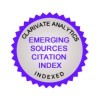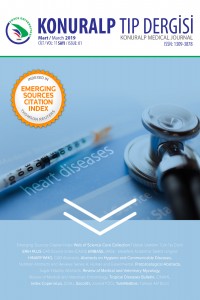Development and Validation of a Personality Type Inventory Based on Enneagram
Abstract
Amaç: Enegram Kişilik Tipleri, birbiriyle bağlantılı dokuz kişilik tipini esas
alan çok eski bir modeldir. Bu araştırmanın amacı, Enegram prensiplerine dayalı
Türkçe bir kişilik tipleri ölçeği geliştirmektir.
Gereç ve Yöntem: Uzman görüşlerine dayanarak ve Delphi yöntemi
kullanarak bir araç geliştirildi. Kırk dört maddeden oluşan son ölçek 156
kişilik Türkçe konuşan bir örnekleme 0-6 arası Likert tipi bir ölçek
kullanılarak uygulandı. Oluşturulan araca uzman doğrulaması, faktör analizi ve
iç güvenilirlik analizleri uygulandı. Ölçeğin sonucu uzman görüşmesi sonucunda
belirlenen kişilik tipleri ile karşılaştırıldı. Veri analizi SPSS 20 sürümü ile
yapıldı.
Bulgular: Katılımcıların 89’u (%57,4) kadın, 66’sı ise (%42,6) erkekti.
Katılımcıların ortalama yaşı 30,52±10,0 yıl idi ve çoğunluğu (n=113; %72,4) üniversite mezunu veya öğrencisi idi. Maddelerin Cronbach
alfa katsayısı 0,839, Split-Half değeri ise birinci bölüm için 0,817, ikinci
bölüm için ise 0,757 olarak hesaplandı. Guttman Split-Half katsayısı 0,520
bulundu. Doğrulayıcı faktör analizi dokuz bileşenin toplam varyansın %60’dan
fazlasını açıkladığını gösterdi. Faktör analizinde 22. Madde hariç bütün
maddelerin faktör yüklerinin 0,411-0,829 arasında olduğu görüldü. Ölçeğin
çeşitli kişilik tiplerini belirlemedeki ortalama duyarlılık ve özgüllük
değerleri sırasıyla %82,8 ve %97,8 olarak hesaplandı. Özgüllük değeri bütün
boyutlar için %94’ün üzerinde bulunurken, tip 4 kişiliğin duyarlılık değeri
%66,7 bulundu.
Sonuç: Taştan Kişilik Tipleri Ölçeği Türklerde Enegram prensiplerine göre
kişilik tiplerini belirlemek amacıyla kullanılabilir.
References
- Enneagram of Personality [Internet]. Wikipedia The Free Encyclopedia. [cited 2018 Feb 2]. Available from: http://en.wikipedia.org/wiki/Enneagram_of_Personality2. Lee JS, Yoon JA, J DK. [Effectiveness of enneagram group counseling for self-identification and depression in nursing college students]. J Korean Acad Nurs. 2013;43(5):649–57. 3. Ginsburg SB. Gurdjieff unveiled: an overview and introduction to Gurdjieff’s teaching. London: Lighthouse Workbooks; 2005. 138 p. 4. Bernier N. The Enneagram Symbol of All & Everything. Brasília: Gilgamesh; 2003. 11 p. 5. Eckstein D. The Couple’s Enneagram Questionnaire (CEQ). Fam J. 2002;10(1):101–8. 6. Baron R, Wagele E. The Enneagram Made Easy: Discover the 9 Types of People. New York: Harper Collins Publishers; 1994. 7. Tastan K. [Combating Stress According to Personality Types]. Elazig: Grafikkent Dijital Baski Merkezi; 2012. 8. Educational Statistics [Internet]. Turkish Statistics Institute. 2014 [cited 2018 Feb 2]. Available from: http://www.tuik.gov.tr/PreHaberBultenleri.do?id=160559. Guimond S, Massrieh W. Intricate correlation between body posture, personality trait and incidence of body pain: A cross-referential study report. PLoS One. 2012;7(5). 10. Allen J, Brock SA. Health Care Communication Using Personality Type: Patients are Different! Philadelphia: Taylor & Francis; 2000. 11. Factor analysis [Internet]. Wikipedia The Free Encyclopedia. [cited 2018 Feb 2]. Available from: http://en.wikipedia.org/wiki/Factor_analysis12. Hermans M, Korrelboom K, Visser S. A Dutch version of the Overall Anxiety Severity and Impairment Scale (OASIS): Psychometric properties and validation. J Affect Disord. 2015;172:127–32. 13. Broen MPG, Moonen AJH, Kuijf ML, Dujardin K, Marsh L, Richard IH, et al. Factor analysis of the Hamilton Depression Rating Scale in Parkinson’s disease. Parkinsonism Relat Disord. 2015;21(2):142–6. 14. Iffland JR, Lockhofen D, Gruppe H, Gallhofer B, Sammer G, Hanewald B. Validation of the German version of the Social Functioning Scale (SFS) for schizophrenia. PLoS One. 2015;10(4). 15. Politi PL, Piccinelli M, Wilkinson G. Reliability, validity and factor structure of the 12‐item General Health Questionnaire among young males in Italy. Acta Psychiatr Scand. 1994;90(6):432–7. 16. Irastorza LJ, Rojano P, Gonzalez-Salvador T, Cotobal J, Leira M, Rojas C, et al. Psychometric properties of the Spanish version of the diagnostic interview for depressive personality. Eur Psychiatry. 2012;27(8):582–90. 17. Hickling FW, Martin J, Walcott G, Paisley V, Hutchinson N, Clarke T, et al. The creation and validation of the Jamaica Personality Disorder Inventory. West Indian Med J. 2013;62(5):389–96. 18. Hur Y, Lee KH. Analysis of Medical Students’ Enneagram Personality Types, Stress, and Developmental Level. Korean J Med Educ. 2011;23(3):175–84. 19. Yilmaz ED, Gencer AG, Unal O, Aydemir O. From Enneagram to Nine Types Temperament Model: A Proposal. Egit ve Bilim. 2014;39(173):393–415. 20. Yilmaz ED, Gencer AG, Aydemir O, Yilmaz A, Kesebir S, Unal O, et al. Validity and reliability of nine types temperament scale. Egit ve Bilim. 2014;39(171):115–37. 21. Allen J, Brock SA, Ford S. Health care communication using personality type: patients are different! Heal Expect. 2002;5(2):182–3.
Abstract
References
- Enneagram of Personality [Internet]. Wikipedia The Free Encyclopedia. [cited 2018 Feb 2]. Available from: http://en.wikipedia.org/wiki/Enneagram_of_Personality2. Lee JS, Yoon JA, J DK. [Effectiveness of enneagram group counseling for self-identification and depression in nursing college students]. J Korean Acad Nurs. 2013;43(5):649–57. 3. Ginsburg SB. Gurdjieff unveiled: an overview and introduction to Gurdjieff’s teaching. London: Lighthouse Workbooks; 2005. 138 p. 4. Bernier N. The Enneagram Symbol of All & Everything. Brasília: Gilgamesh; 2003. 11 p. 5. Eckstein D. The Couple’s Enneagram Questionnaire (CEQ). Fam J. 2002;10(1):101–8. 6. Baron R, Wagele E. The Enneagram Made Easy: Discover the 9 Types of People. New York: Harper Collins Publishers; 1994. 7. Tastan K. [Combating Stress According to Personality Types]. Elazig: Grafikkent Dijital Baski Merkezi; 2012. 8. Educational Statistics [Internet]. Turkish Statistics Institute. 2014 [cited 2018 Feb 2]. Available from: http://www.tuik.gov.tr/PreHaberBultenleri.do?id=160559. Guimond S, Massrieh W. Intricate correlation between body posture, personality trait and incidence of body pain: A cross-referential study report. PLoS One. 2012;7(5). 10. Allen J, Brock SA. Health Care Communication Using Personality Type: Patients are Different! Philadelphia: Taylor & Francis; 2000. 11. Factor analysis [Internet]. Wikipedia The Free Encyclopedia. [cited 2018 Feb 2]. Available from: http://en.wikipedia.org/wiki/Factor_analysis12. Hermans M, Korrelboom K, Visser S. A Dutch version of the Overall Anxiety Severity and Impairment Scale (OASIS): Psychometric properties and validation. J Affect Disord. 2015;172:127–32. 13. Broen MPG, Moonen AJH, Kuijf ML, Dujardin K, Marsh L, Richard IH, et al. Factor analysis of the Hamilton Depression Rating Scale in Parkinson’s disease. Parkinsonism Relat Disord. 2015;21(2):142–6. 14. Iffland JR, Lockhofen D, Gruppe H, Gallhofer B, Sammer G, Hanewald B. Validation of the German version of the Social Functioning Scale (SFS) for schizophrenia. PLoS One. 2015;10(4). 15. Politi PL, Piccinelli M, Wilkinson G. Reliability, validity and factor structure of the 12‐item General Health Questionnaire among young males in Italy. Acta Psychiatr Scand. 1994;90(6):432–7. 16. Irastorza LJ, Rojano P, Gonzalez-Salvador T, Cotobal J, Leira M, Rojas C, et al. Psychometric properties of the Spanish version of the diagnostic interview for depressive personality. Eur Psychiatry. 2012;27(8):582–90. 17. Hickling FW, Martin J, Walcott G, Paisley V, Hutchinson N, Clarke T, et al. The creation and validation of the Jamaica Personality Disorder Inventory. West Indian Med J. 2013;62(5):389–96. 18. Hur Y, Lee KH. Analysis of Medical Students’ Enneagram Personality Types, Stress, and Developmental Level. Korean J Med Educ. 2011;23(3):175–84. 19. Yilmaz ED, Gencer AG, Unal O, Aydemir O. From Enneagram to Nine Types Temperament Model: A Proposal. Egit ve Bilim. 2014;39(173):393–415. 20. Yilmaz ED, Gencer AG, Aydemir O, Yilmaz A, Kesebir S, Unal O, et al. Validity and reliability of nine types temperament scale. Egit ve Bilim. 2014;39(171):115–37. 21. Allen J, Brock SA, Ford S. Health care communication using personality type: patients are different! Heal Expect. 2002;5(2):182–3.
Details
| Primary Language | English |
|---|---|
| Subjects | Health Care Administration |
| Journal Section | Articles |
| Authors | |
| Publication Date | March 25, 2019 |
| Acceptance Date | January 25, 2019 |
| Published in Issue | Year 2019 Volume: 11 Issue: 1 |
Cite
Cited By
Muhasebe Hizmeti Alan Mükelleflerin Kişilik Özelliklerinin Müşteri Bağlılığı İle İlişkisi
OPUS Uluslararası Toplum Araştırmaları Dergisi
Dursun BOZ
https://doi.org/10.26466/opus.612220
Türkçe bir örneklemde enneagrama dayalı kişilik tiplerinin sıklığı: Web tabanlı kesitsel bir çalışma
Ortadoğu Tıp Dergisi
Zekeriya AKTÜRK
https://doi.org/10.21601/ortadogutipdergisi.722751
Validity and reliability of enneagram personality types and subtypes inventory in a Turkish sample
Anadolu Kliniği Tıp Bilimleri Dergisi
https://doi.org/10.21673/anadoluklin.1104082
Enneagram Kişilik Tiplerinin Besin Seçimi ile İlişkisinin Araştırılması: Kesitsel Çalışma
Süleyman Demirel Üniversitesi Sağlık Bilimleri Dergisi
https://doi.org/10.22312/sdusbed.1431746
Üniversite Öğrencilerinin Enneagram Kişilik Tipleri ile Düşünme Stilleri Arasındaki İlişkinin İncelenmesi
İstanbul Gelişim Üniversitesi Sosyal Bilimler Dergisi
https://doi.org/10.17336/igusbd.1197620
Öğretmenlerin Enneagram Kişilik Tipleri ile Sınıf Yönetimi Becerileri Arasındaki İlişkinin İncelenmesi
Ihlara Eğitim Araştırmaları Dergisi
https://doi.org/10.47479/ihead.1409084
Öğretmen Adaylarının Enneagram Kişilik Tipleri ile Sınıf Yönetimi Öz-Yeterlik İnançları Arasındaki İlişki
İnsan ve Toplum Bilimleri Araştırmaları Dergisi
https://doi.org/10.15869/itobiad.1379771
Enneagram Kişilik Tiplerinin Akılcı ve Sezgisel Karar Verme Stilleri Üzerindeki Etkisi
İnsan ve Toplum Bilimleri Araştırmaları Dergisi
https://doi.org/10.15869/itobiad.1655904





